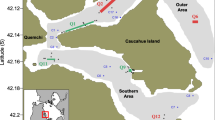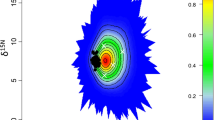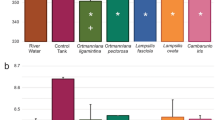Abstract
The impact of suspended mussel culture (Mytilus edulis, M. trossulus) on the benthos of a small Nova Scotia cove (7 m depth) was assessed using meehods involving both benthic metabolism and community structure. Due to deposition of mussel feces and pseudofeces, sedimentation rate was higher under the mussel culture lines than at an adjacent reference site of similar sediment texture. Porewater profiles of sediment sulfate and sulfide indicated greater anaerobic metabolism at the mussel site than at the reference site, but sulfide was absent from the upper centimeters of sediments under the mussels. Seasonal measures of sediment oxygen demand showed little change between sites, but maximum rates of ammonium release at the mussel site were twice the highest rates measured at the reference site. Abundance of benthic macrofauna was higher at the reference site, but biomass was generally lower. Biomass at the mussel site was dominated by molluscs (Ilyanassa spp. andNucula tenuisulcata), that were attracted to mussels fallen from the culture and/or enriched organic matter due to biodeposition. Species diversity was lower at the reference site due to the dominance of the polychaeteNephtys neotena. Abundance-biomass comparisons (ABC method) of faunal analysis did not indicate any impact of biodeposition at this site: however, disturbance did not result in a typical assemblage of small opportunistic species anticipated with this method. Cluster analysis of macrofauna usually provided a clear separation between the sites. Since the contruction of a causeway (1968), foraminifera species composition showed a temporal response to temperature changes in the cove by shifting toward calcareous species, but assemblages downcore showed little or no relationship to aquaculture impacts. Although there is a shift toward anaerobic metabolism at the mussel lines, the impact of mussels falling to the sediments was more noticeable in benthic community structure than was any impact due to organic sedimentation or hypoxia. In general the impact of aquaculture on the benthos appeared to be minor. Furtyher assesment of these consequences may mandate both taxonomic and energetic approaches to impact assessment.
Similar content being viewed by others
Literature Cited
Alve, E. andJ. Nagy. 1986. Estuarine foraminiferal distribution in Sandebukta, a branch of the Oslo Fjord.Journal of Foraminifera Research 16:261–284.
Aschan, M. A. andA. M. Skullerud. 1990. Effects of changes in sewage pollution on soft-bottom macrofauna communities in the inner Oslojord, Norway.Sarsia 75:169–190.
Asmus, R. M. andH. Asmus. 1991. Mussel beds—limiting or promoting phytoplankton.Journal of Experimental Marine biology and Ecology 148:215–232.
Baudinet, D., E. Alliot, B. Berland, C. Grenz, M. Plante-Cuny, R. Plante, andC. Salen-Picard. 1990. Incidence of mussel culture on biogeochemical fluxes at the sediment-water interface.Hydrobiologia 207:187–196.
Beukema, J. J. 1988. An evaluation of the ABC-method (abundance/biomass comparison) as applied to macrozoobenthic communities living on tidal flats in the Dutch Wadden Sea.Marine Biology 99:425–433.
Buckley, D. A., E. Owens, C. T. Schafer, C. Vilks, R. E. Cranston, M. A. Rashid, F. J. E. Wagner, andD. A. Waolker. 1974. Canso Strait and Chedabucto Bay: Multidisciplicary study of the impact of man on the marine environment. Offshore Geology of Eastern Canada, Geological Survey of Canada Paper. 74–30, 133–160.
Buzas, M. A. 1969. On quantification of biofacies, Proceedings of the North American Paleontological govention, 101–116.
Clark, D. F. 1971. Effects of aquaculture outfall on benthonic foraminifera in Clam Bay, Nova Scotia.Maritine Sediments 2: 76–84.
Clark, K. R. 1990. Comparison of dominance curves.Journal of Experimental marine biology and Ecology 138:143–157.
Curtis, L. A. andL. E. Hurd. 1979. on the broad nutritional requirements of the mud snail,Ilyanassa (Ilyanassa) obsoleta (Say) and its polytrophic role in the food web.Journal of Experimental Marine Biology and Ecology 41:289–297.
Dahlbäck, B. andL. Å. H. Gunnarsson. 1981. Sedimentation and sulphate reduction under a mussel culture.Marine Biology 63:269–275.
Dame, R. F., N. Dankers, T. Prins, H. Jongsma, andA. Smaal. 1991. The influence of mussel beds on nutrients in the Western Wadden Sea and Eastern Scheldt estuaries.Estuaries 14: 130–138.
Dauer, D. M., M. W. Luckenbach, andA. J. Rodi, Jr. 1993. Abundance biomass comparison (ABC method): Effects of an estuarine gradient, anoxic/hypoxic events and contaminated sediments.Marine Biology 116:507–518.
Dayton, P. K. 1975. Experimental evaluation of ecological dominance in a rocky intertidal algal community.Ecological Monographs 45:137–159.
Diaz, R. J. 1992. Ecosystem assessment using estuarine and marine benthic community structure, p. 67–85.In G. A. Burton, Jr. (ed.), Sediment Toxicity Assessment. Lewis Publishers, Boca Raton, Florida.
Ellison, R. L., R. Broome, andR. Ogilvie. 1986 Foraminiferal and trace metal content in the Patapsco River and Baltimore Harbour, Maryland.Marine Pollution Bulletin 17:419–423.
Fenchel, T. andT. H. Blackburn. 1979. Bacteria and Mineral Cycling. Academic Press, London.
Folk, R. L. 1974. Petrology of Sedimentary Rocks. Hemphills, Austin, Texas.
Folke, C., andN. Kautsky. 1989. The role of ecosystems for a sustainable development of aquaculture.Ambio 18:234–243.
Frid, C. L. J. andT. S. Mercer. 1989. Environmental monitoring of caged fish farming in macrotidal environments.Marine Pollution Bulletin 20:379–383.
Gowen, R. J. andN. B. Bradbury. 1987. The ecological impact of salmonid farming in coastal waters: A review.Oceanography and Marine Biology Annual Review 25:563–575.
Grant, J., M. Dowd, K. Thompson, C. Emerson, andA. Hatcher. 1993. Perspectives on field studies and related biological models of bivalve growth and carrying capacity, p. 370–419.In R. Dame (ed.) The Role of Filter-feeding Bivalves in Marine Ecosystem Processes. Springer-Verlag, New York.
Gray, J. S. 1981. The Ecology of Marine Sediments. Cambridge University Press, Cambridge.
Gray, J. S., K. R. Clarke, R. M. Warwick andG. Hobbs. 1990. Detection of initial effects of pollution on marine benthos: An example from Ekofisk and Eldfisk oilfields, North Sea.Marine Ecology Progress Series 66:285–299.
Gray, J. S. andF. B. Mizra. 1979. A possible method for the dection of pollution-induced disturbance on marine benthic communities.Marine Pollution Bulletin 10:142–146.
Green, M. A., R. C. Aller, andJ. Y. Aller. 1993. Carbonate dissolution and temporal abundances of foraminifera in Long Island Sound sediments.Limnology and Oceanography 38:331–3345.
Grenz, C., M. Hermin, D. Baudinet, andR. Daumas. 1990. In situ biochemical and bacterial variation of sediments enriched with mussel deposts.Hydrobiologia 207:153–160.
Grizzle, R. E. andC. A. Penniman. 1991. Effects of organic enrichment on estuarine macrofaunal benthos: A comparison of sediment profile imaging and traditional methods.Marine Ecology Progress Series 74:249–262.
Hansen, L. S. andT. H. Blackburn. 1991. Aerobic and anaer obic mineralization of organic material in marine sediment microcosms.Marine Ecology Progress Series 75:283–291.
Hargrave, B. T., D. E. Duplisea, E. Pfeiffer, andD. J. Wildish. 1993. Seasonal changes in benthic fluxes of dissolved oxygen and ammonium associated with marine cultured Atlantic salmon.Marine Ecology Progress Series 96:249–257.
Hatcher, A., J. Grant, andB. Schofield. 1994. The effects of suspended mussel culture (Mytilus spp.) on sedimentation, benthic respiration, and sediment nutrient dynamics in a coastal bay.Marine Ecology Progress Series 115:219–235.
Holmer, M. andE. Kristensen. 1992. Impact of marine fish cage farming on metabolism and sulfate reduction of underlying sediments.Marine Ecology Progress Series 80:191–201.
Hunt, J. H., W. G. Ambrose, Jr., andC. H. Peterson. 1987. Effects of the gastropodIlyanassa obsoleta (Say) and the bivalveMercenaria mercenaria (L.) on larval settlement and juvenile recruitment of infauna.Journal of Experimental Marine Biology and Ecology 108:229–240.
Jaramillo, E., C. Bertran, andA. Bravo. 1992. Community structure of the subtidal macroinfauna in an esturaine mussel bed in southern Chile.Marine Ecology 13:317–331.
Jørgensen, B. B. 1977. The sulfur cycle of a coastal marine sediment (Limfjorden, Denmark).Limnology and Oceanography 22:814–832.
Jørgensen, B. B. andJ. Srensen. 1985. Seasonal cycles of O2, NO3, and SO4 reduction in estuarine sediments: The significance of NO3 reduction maximum in spring.Marine Ecology Progress Series 24:65–74.
Josefson, A. B. andWidbom. 1988. Differential response of benthic macrofauna and meiofauna to hypoxia in the Gullmar Fjord basin.Marine Biology 100:31–40.
Kaspar, H. F., P. A. Gillespie, I. C. Boyer, andA. L. MacKenzie. 1985. Effects of mussel aquaculture on the nitrogen cycle and benthic communities in Kenepuru Sound, Marlborough Sounds, New Zealand.Marine Biology 85:127–136.
Kautsky, N. andS. Evans. 1987. Role of biodeposition byMytilus edulis in the circulation of matter and nutrients in a baltic coastal ecosystem.Marine Ecology Progress Series 38:201–212.
Kemp, W. M., P. Sampou, J. Caffrey, M. Mayer, K. Henriksen, andW. R. Boynton. 1990. Ammonium recycling versus denitrification in Chesapeake Bay sediments.Limnology and Oceanography 35:1545–1563.
Larsson, A. M. 1985. Blue mussel sea farming—Effects on water quality.Vatten/Water 41:218–224.
Mallet, A. L. andC. E. Carver. 1991. An assessment of strategies for growing mussels in suspended culture.Journal of Shellfish Research 10:471–478.
Mattsson, J. andO. Linden. 1983. Benthic macrofauna succession under mussels,Mytilus edulis L. (Bivalvia) cultured on hanging long-lines.Sarsia 68:97–102.
Nickell, T. D. andP. G. Moore. 1992. The behavioural ecology of epibenthic scavenging invertebrates in the Clyde Sea area: Laboratory experiments on attractions to bait in static water.Journal of Experimental Marine Biology and Ecology 156:217–224.
O'Connor, B. D. S., J. Costelloe, B. F. Keegan, andD. C. Rhoads. 1989. The use of REMOTS@ technology in monitoring coastal enrichment resulting from mariculture.Marine Pollution Bulletin 20:384–390.
Parsons, T. R., Y. Maita, andC. M. Lalli. 1984. A Manual of Chemical and Biological Methods for Seawater Analysis. Pergamon Press. Oxford. United Kingdom.
Pearson, T. H., J. S. Gray, andP. J. Johannessen. 1983. Objective selection of sensitive species indicative of pullution-induced change in benthic communities. 2. Data analyses.Marine Ecology Progress Series 12:237–255.
Pearson, T. H. andR. Rosenberg. 1978. Macrobenthic succession in relation to organic enrichment and pollution of the marine environment.Oceanography and Marine Biology Annual Review 16:229–311.
Posey, M. H. 1990. Functional approaches to soft substrate communities: How useful are they?Reviews in Aquatic Sciences 2:343–356.
Prakash, A. 1989. Environmental implications of coastal aquaculture. Bulletin of the Aquaculture Association of Canada, September, 109–111.
Rachor, E., W. E. Arntz, H. Rumohr, andK. H. Mantau. 1982. Seasonal and long-term population fluctuations inDiastylis rathkei (Crustacea: Cumacea) of Kiel Bay and German Bight.Netherlands Journal of Sea Research 16:141–150.
Rhoads, D. C. 1963. Rates of sediment reworking byYoldia limatula in Buzzard's Bay, Massachusetts, and Long Island Sound.Journal of Sedimentary Petrology 33:723–727.
Rhoads, D. C., P. L. McCall, andJ. Y. Yingst. 1978. Disturbance and production on the estuarine seafloor.American Scientist 66:577–586.
Rhoads, D. C. andD. K. Young. 1970. The influence of deposit feeding organisms on sediment stability and community trophic structure.Journal of Marine Research 28:150–156.
Ritz, D. A., M. E. Lewis, andM. A. Sken. 1989. Response to organic enrichment of infaunal macrobenthic communities under salmonid seacages.Marine Biology 103:211–214.
Rowell, T. W. andP. Woo. 1990. Predation by the nemertean worm,Cerebratulus lacteus Verrill, on the soft-shell clam,Myaarenaria Linnaeus, 1758, and its apparent role in the destruction of a clam flat.Journal of Shellfish Research 9:291–297.
Sampou, P. andC. A. Oviatt. 1991. A carbon budget for a eutrophic marine ecosystem and the role of sulphur metabolism in sedimentary carbon, oxygen and energy dynamics.Journal of Marine Research 49:825–844.
Schafer, C. T. 1970. Studies of benthonic foraminifera in the Restigouche Estuary: 1. Faunal distribution patterns near pollution sources.Maritime Sediments 6:121–134.
Schafer, C. T. 1973. Distribution of foraminifera near pollution sources in Chaleur Bay.Water, Air and Soil Pollution 2:219–233.
Schafer, C. T. andF. E. Cole. 1974. Distributions of benthonic foraminifera: Their use in delimiting local nearshore environments. Offshore Geology, Eastern Canada, Geological Survey of Canada Paper 74-1, Pt. B: 23–126.
Schafer, C. T. andF. E. Cole. 1976. Foraminiferal distribution patterns in the Restigouche Estuary: 1st International Symposium on Benthonic Foraminifera of the Continental Margins: Part A. Ecology and Biology.Maritime Sediments, Special Publication No. 1:1–24.
Schafer, C. T., E. S. Collins, andJ. N. Smith. 1991. Relationship of foraminifera and thecamoebian distributions to sediments contaminated by pulp mill effluent: Saguenay Fiord, Quebec, Canada.Marine Micropaleontology 17:255–283.
Schafer, C. T., F. J. E. Wagner, andC. Ferguson. 1975. Occurrence of foraminifera, molluscs, and ostracods adjacent to the industrialized shoreline of Canso Strait, Nova Scotia.Water, Air and Soil Pollution 5:79–96.
Scheltema, R. S. 1964. Feeding habits and growth in the mudsnailIlyanassa obsoletus.Chesapeake Science 5:161–166.
Schubert, A. andK. Reise. 1986. Predatory effects ofNephtys hombergii on other polychaetes in tidal flat sediments.Marine Ecology Progress Series 34:117–124.
Scott, D. B. 1977. Distribution and population dynamics of marsh-estuarine foraminifera with applications to relocating Holocene sea levels. Ph.D. Dissertation, Dalhousie University, Halifax, Canada.
Scott, D. B. andJ. O. R. Hermelin. 1993. A device for precision splitting of micropaleontological samples in liquid suspension.Journal of Paleontology 67:151–153.
Scott, D. B. andF. S. Medioli. 1980. Living vs. total foraminiferal populations: Their relative usefulness in paleoecology.Journal of Paleontology 54:814–837.
Scott, D. B., F. S. Medioli, andC. T. Schafer. 1977. Temporal changes in foraminifera distributions in Miramichi River estuary.Canadian Journal of Earth Sciences 7:1566–1587.
Scott, D. B., C. T. Schafer, andF. S. Medioli. 1980. Eastern Canadian estuarine foraminifera: A framework for comparison.Journal of Foraminiferal Research 10:205–234.
Silvert, W. 1992. Assessing environmental impacts of finfish aquaculture in marine waters.Aquaculture 107:67–79.
Stasek, C. R. 1965. Feeding and particle-sorting inYoldia ensifera (Bivalvia: Protobranchia), with notes on other nuculanids.Malacologia 2:349–366.
Tenore, K. R., L. F. Boyer, R. M. Cal, J. Corral, C. Garcia-Ferdandez, N. Gonzalez, E. Gonzalez-Gurriaran, R. B. Hanson, M. Krom, E. Lopez-Jamar, J. McClain, M. M. Pamatmat, A. Perez, D. C. Rhoads, G. DeSantiago, J. Tietjen, J. Westrich, andH. L. Windom. 1982. Coastal upwelling in the Rias Bajas, n.w. Spain, contrasting benthic regimes of the Rias de Arosa and de Muros.Journal of Marine Research 40: 701–772.
Tsutsumi, H., T. Kikuchi, M. Tanaka, T. Higashi, K. Imasaka, andM. Miyazaki. 1991. Benthic faunal succession in a cove organically polluted by fish farming.Marine Pollution Bulletin 23:233–238.
Vilks, G., C. T. Schafer, andD. A. Walker. 1975. Influence of a causeway on oceanography and foraminifera in the Strait of Canso, Nova Scotia.Canadian Journal of Earth Sciences 12:2086–2102.
Wagner, F. J. E. andC. T. Schafer. 1980. Upper Holocene paleoceanography of Inner Miramichi Bay.Maritime Sediments 16:5–10.
Warwick, R. M. 1986. A new method for detecting pollution effects on marine macrobenthic communities.Marine Biology 92:557–562.
Warwick, R. M., T. H. Pearson, andT. H. Ruswahyuni. 1987. Detection of pollution effects on marine macrobenthos: Further evaluation of the species abundance biomass method.Marine Biology 95:193–200.
Wefer, G. 1976. Umwelt, produktion und sedimentation benthischen foraminiferen in der Westlichen Ostee. Reports Sonderforschungsbereich 95, Universität Kiel, no. 14.
Weston, D. P. 1990. Quantitative examination of macrobenthic community changes along an organic enrichment gradient.Marine Ecology Progress Series 61:233–244.
Wilkinson, L. 1990. SYSTAT: The system for statistics. SYSTAT Inc., Evanston, Illinois.
Wilson, W. H. 1991. Competition and predation in marine soft-sediment communities.Annual Review of Ecology and Systematics 21:221–241.
Author information
Authors and Affiliations
Rights and permissions
About this article
Cite this article
Grant, J., Hatcher, A., Scott, D.B. et al. A multidisciplinary approach to evaluating impacts of shellfish aquaculture on benthic communities. Estuaries 18, 124–144 (1995). https://doi.org/10.2307/1352288
Received:
Accepted:
Issue Date:
DOI: https://doi.org/10.2307/1352288




